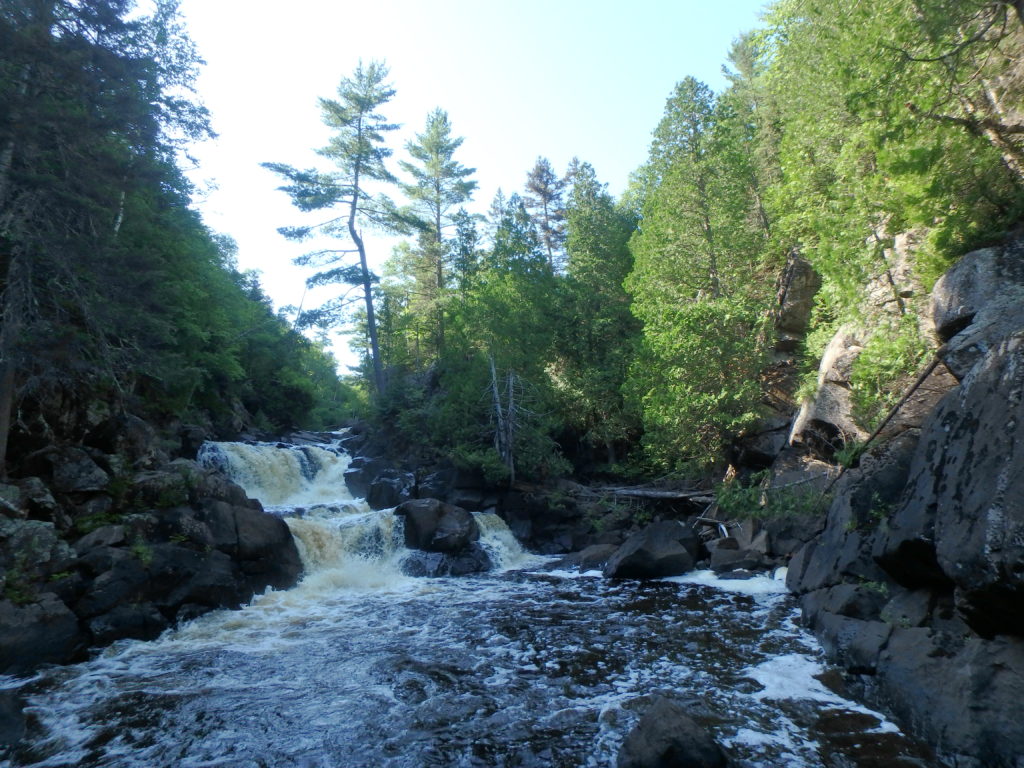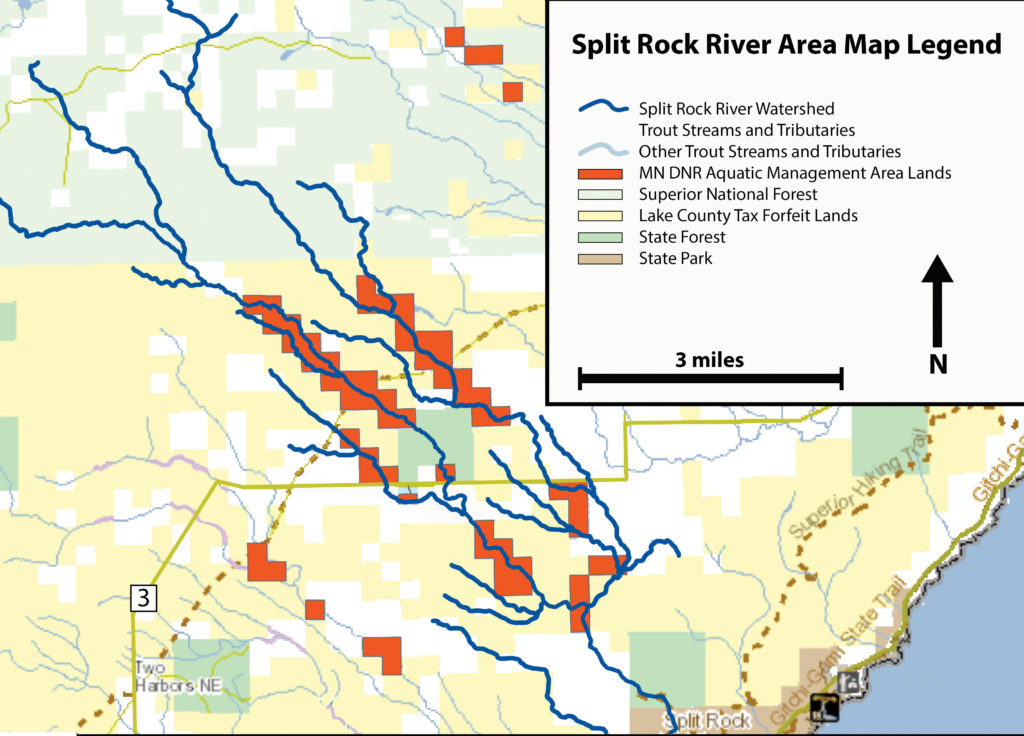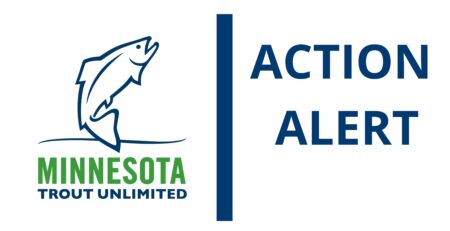Timber Harvest on Aquatic Management Lands
DNR to Cut 90% of AMAs on North Shore
Under the DNR’s proposed “Sustainable Timber Harvest Analysis” plan, the DNR intends to harvest trees from 90% of the land the Fisheries Section owns along trout and steelhead rivers in Lake County. This includes riparian forests along premier rivers such as the Split Rock, Beaver, Baptism and Manitou. By state law, these Aquatic Management Areas (AMAs) can and should only be managed for the purpose of protecting trout and steelhead fisheries, habitat and water quality. How is it that this overzealous cutting of Fisheries lands is even being considered? What can you do to stop this bad idea in its tracks?
How We Got Here: the Sustainable Timber Harvest Analysis
The Minnesota DNR manages approximately 5.4 million acres of land statewide. This includes large amounts of non-forested land (31%), “non-manageable” forested land (12%), and forested lands with trees the DNR considers not “merchantable.” The remaining 2.75 million acres of DNR lands (50% of the total) is managed by DNR largely for timber production, although this total also includes land managed by the DNR’s Wildlife and Fisheries Sections. The DNR develops forest management plans approximately every 10 years. For the past 15 years, the DNR’s “sustainable harvest” target has been 800,000 cords annually. While the history is a little murky, it appears that in 2016 members of the forest products industry opined that these harvest levels were too low and that one million cords should be cut annually.
In November 2016, Governor Mark Dayton directed the DNR to conduct an analysis to determine whether harvesting one million cords of timber per year from DNR forest lands is sustainable and, if it is not, to identify an alternate sustainable harvest number. The DNR was directed to use an independent third party to conduct this analysis and identify the sustainable timber harvest level by March 1, 2018.
The DNR contracted with a forest management consulting firm based in Portland, Oregon, Mason, Bruce & Girard, to perform this analysis. This is called the “Sustainable Timber Harvest Analysis” and is referred to by the acronym “STHA.” In addition to reviewing wood and fiber supply, the analysis considered biodiversity, wildlife habitat, water quality, tree productivity and invasive species. The analysis used lots of data, created a statistical model and performed in-depth modeling. Stakeholders representing timber, conservation, environmental, and public landowner interests provided input, but the process was primarily driven by DNR staff.
The STHA was released in February 2018. The lengthy report and explanation of the model can easily be found on the DNR website by searching “sustainable timber harvest.” The study concluded that while an annual harvest of 880,000 to 910,000 cords might be possible in the short term, the sustainable harvest level, which gives greater consideration of wildlife values, is 600,000 to 800,000 cords per year. In March 2018 the DNR set a new 10-year timber target of 870,000 cords offered for sale annually from DNR-managed forest lands.
Improper Inclusion of AMAs in Harvest Pool
In addition to numerous trout stream easements, the Fisheries Section owns outright many sensitive parcels of land surrounding some of Minnesota’s best trout and steelhead rivers. These parcels are designated “Aquatic Management Areas” under state statute, and management, including tree cutting, may only be performed for the purpose of protecting fisheries, fisheries habitat, water quality and intrinsic biological values. For reasons that are not clear, but which appear to be vestiges of a hand-shake political deal more than a decade ago, the DNR included all 8,017 acres of AMAs in Lake County in the STHA. And although Lake County AMAs account for 0.3% of the 2.75 million acre harvest pool statewide, somehow the DNR model has decided that 7,260 of these 8,017 acres will be harvested over the next 10 years! This is 90% of the AMAs along popular Lake County trout and steelhead rivers.

Changing Forest Conditions Require Active Management
It is important to point out that sometimes northern forests need tree harvest and planting to produce conditions most favorable for long term health of coldwater fisheries. In the northern two-thirds of the state, trout and steelhead fisheries are products of the forests in their watersheds. How well the forests within a given watershed have been managed in the past and how well they are managed in the future determine to what degree the coldwater fisheries in streams flowing through them will be productive, or whether the fisheries will vanish entirely. A healthy forest is essentially a sponge, which holds precipitation, both snowmelt and rainfall, and slowly releases it over time. A healthy forest reduces destructive peak flows and increases base flows, especially in warm summer months.
Fisheries biologists and foresters know that trout and steelhead fisheries benefit most from older forests with long-lived species capable of providing greater water storage, mature canopy, a supply of future large wood (as old trees fall into the floodplain), and riparian tree species not attractive to beavers. However, given the hodgepodge of past activities, tree diseases and pests, many forest stands lack these conditions and cannot reach or maintain these desirable conditions without tree harvest and tree planting. MNTU recognizes that northern Minnesota’s forests, including in AMAs, often need active management in order to achieve a healthy, mature forest that will store water and slowly release it into trout streams. Need for active management is increasing given the warming climate and the waves of tree pests and diseases it will bring. Indeed, without intervention, many forests will degenerate into brushland.
For these reasons MNTU is not opposed to tree harvest. Far from it. We are working with land managers along the North Shore to increase tree harvest in many areas in order to convert the forests back to long-lived species capable of providing greater water storage and canopy. Foresters, land managers and loggers are our partners. We look forward to increasing our involvement in tree harvest and tree planting activities. However, flaws in the DNR’s Sustainable Timber Harvest Analysis, described in the preceding section, will impose wood harvest targets on sensitive Fisheries lands that are too high. Unless corrected, these timber volume quotas will replace fisheries management goals and will lead to excessive or premature tree harvest to the detriment of prized trout and steelhead fisheries.
Inclusion of AMAs Violates Law and Betrays Anglers
As noted above, the Fisheries Section owns many lands along important trout streams and lakes for the purpose of protecting and managing the land for fish. These lands, designated as “aquatic management areas” (AMAs) under Minnesota Statute 86A.05, Subdivision 14, are subject to limitations on how they can be managed:
“Aquatic management areas. (a) Aquatic management areas may be established to protect, develop, and manage lakes, rivers, streams, and adjacent wetlands and lands that are critical for fish and other aquatic life, for water quality, and for their intrinsic biological value, public fishing, or other compatible outdoor recreational uses… (d) Aquatic management areas must be administered by the commissioner of natural resources in a manner consistent with the purposes of this subdivision to perpetuate and, if necessary, reestablish high quality aquatic habitat for production of fish, wildlife, and other aquatic species. Public fishing and other uses shall be consistent with the limitations of the resource, including the need to preserve adequate populations and prevent long-term habitat injury or excessive fish population reduction or increase.”
We have no objection to tree harvest being undertaken on AMAs, but only if it is being done for the purpose of improving the fishery. In such cases, the management for fisheries purposes has a side benefit for the timber industry. However, by including AMA lands in the pool of lands subject to harvest, the DNR has impermissibly made fisheries protection subservient to purposes not allowed by state law (such as timber production) even where timber harvest on the AMAs may be harmful to the fishery. Timber production is not one of the allowable purposes of Minnesota Statute 86A.05, Subdivision 14, and including AMA lands in the pool of lands for timber harvest is a violation of state law.
90% of AMA Lands on Trout and Steelhead Rivers Will be Harvested
The 10-year timber harvest pool generated by the STHA model reveals it has fundamental flaws. When MNTU raised concerns about the STHA and its inclusion of AMAs in the potential harvest pool, DNR managers pointed out that AMAs account for just 0.3% of the harvest pool statewide, and 1.3% of the harvest pool in the North Shore forest planning area. But this theoretical 1.3 % of the harvest pool in the North Shore forest planning area amounts to 7,260 acres of the 8,017 acres of Lake County AMAs, which is 90% of the AMA parcels along premier trout and steelhead rivers in Lake County, including the Split Rock, Beaver, Baptism and Manitou.

The map above provides a graphic example of the alarming cut list being generated by the DNR model. Notice how in the past the DNR Fisheries Section had the foresight to protect the land surrounding long sections of the Split Rock River. The Fisheries-owned lands which other parts of the agency insist be offered for harvest in the next 10 years are shown in red. Can harvesting all these parcels within such a short timespan be anything but disastrous for these streams and fisheries?
Dispute Resolution Process Lacks Any Criteria
The DNR has suggested that the area fisheries supervisor can prevent this misguided harvest of AMAs through the DNR’s “dispute resolution process,” titled “Interdisciplinary Forest Management Coordination Framework.” This policy describes a process of discussion up the DNR chain of command from area level to the commissioner’s office, but offers no criteria or standards by which agency officials will weigh the competing positions. It seems to invite politically-based decision making, rather than science-based decision making.
Sacrifice of Other AMA Land Required to Protect A Targeted Parcel
Even if an area fisheries supervisor succeeds in convincing his or her counterpart in the Forestry Division that a particular AMA in the harvest pool should not be cut, internal DNR policies nonetheless require that another AMA parcel in the area be substituted in. This is outrageous. If the best outcome for the fisheries is to not harvest the trees on a targeted AMA, the manager and trout and steelhead anglers should not be penalized. In the case of Lake County AMAs, no matter how compelling the reasons are not to cut stands, nor even the agreement of local foresters, 7,260 acres or 90% of Lake County AMAs will be cut over in the next 10 years. This policy of mandatory substitution and sacrifice must stop.
Refusal to Plant Trees Guarantees Conversion to Brushland
Currently the Forestry Division can offer up AMAs for timber harvest auction over the reasonable objections of Fisheries Section managers. It even charges the Fisheries Section for time spent preparing timber sales on AMAs which the Fisheries manager believes will harm fisheries. This is bad enough. But what is worse is that the Forestry Division refuses to follow best management practices and plant long-lived tree species needed to produce the healthy older forests desirable for fisheries protection. Instead of active intervention to prevent degeneration to brushland, AMAs are receiving unwanted and untimely harvests with no plantings. This all but guarantees a slow conversion to brush rather than mature forest. This problem preceded the STHA, but accelerated harvest under the STHA quotas will exacerbate the problem. No timber harvest should occur on AMAs unless adequate funding is available and earmarked to immediately plant the parcel with long-lived tree species capable of producing a mature forest resilient to climate change and tree pests.
What’s Next?
Earlier this month, MNTU brought these concerns to the attention of top management within the DNR. We expressed our belief that: (1) AMAs should be managed for fisheries purposes only, with timber production only an incidental side benefit, (2) AMAs should not be included in the STHA or harvest pool generated by it, (3) the DNR should eliminate from forest management planning processes the requirement that another AMA must be substituted in order for an AMA to be removed from the harvest pool, and (4) no AMA in the northern forested region should be harvested unless funding is available and earmarked for concurrent tree planting pursuant to a plan designed to achieve and maintain healthy, mature forest conditions which maximum coldwater fisheries outcomes.
As of February 21, 2020, the DNR has not released the final 10-year stand list, nor have we heard how or whether the DNR would be addressing our concerns. The point person representing the interests of anglers and hunters in intra-agency negotiations and implementation of the STHA is Dave Olfelt, Director of the Division of Fish and Wildlife. He can be reached at: dave.olfelt@state.mn.us

